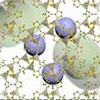| Oct 03, 2024 |
|
(Nanowerk News) With advancements in nanotechnology, scientists have been able to create more artificial chiral nanomaterials. One of the key features of these materials is circular dichroism (CD), which is an optical property used for sensing. CD is more sensitive than many other methods but can’t be used for real-time imaging inside living organisms. To address this, researchers have developed chiral nanocomposites with added biological functions.
|
|
However, some of these materials are unstable in complex biological environments, causing them to break down or give inaccurate results. Another issue is that some nanocomposites struggle to detect specific molecules when other substances have similar properties. This makes it challenging to create stable nanomaterials that can perform reliably in medical diagnosis and detection.
|
|
In a recent study published in Light: Science & Application (“Upconversion-based chiral nanoprobe for highly selective dual-mode sensing and bioimaging of hydrogen sulfide in vitro and in vivo”), Professor Geyu Lu and his team at Jilin University in China developed a new nanocomposite probe that can sense hydrogen sulfide (H2S) and be used for imaging.
|
 |
| Schematic illustration of the UCNPs/Cux@ZIF nanoprobes and their applications in H2S biosensing. The designed UCNPs is encapsulated in ZIF-8 along with Cux nanoparticles. Due to the quenching of UCL by Cux, the UCL signal of UCNPs/CuxOS@ZIF nanocomposite probe under 980 nm excitation is weak. At this time, the probe showed a significant CD signal due to Cux. When H2S exists in the detection environment, the destruction of Cux by H2S weakens the CD signal of the probe, while the UCL signal of UCNPs is restored. Based on this principle, UCL/CD dual-mode sensing against H2S is realized in vitro. At the same time, as one of the typical biomarkers of cancer, the high expression of H2S in the tumor also enhances the UCL signal of the probe inside the tumor, achieving bioimaging in vivo. (Image: Light Publishing Center, Changchun Institute of Optics, Fine Mechanics And Physics)
|
|
This probe, made of upconversion nanoparticles (UCNPs) and chiral CuxOS nanoparticles encased in a zeolitic imidazolate framework (ZIF-8), changes its optical signals when H2S is present. It can detect H2S in test environments and perform real-time imaging inside living mice with tumors. This development makes chiral sensing more useful for detecting biological processes and opens new possibilities for using chiral nanomaterials in medicine.
|
|
The design of this nanocomposite is effective at filtering out interference, allowing it to detect H2S with high accuracy. According to the researchers, the ZIF-8 shell plays a crucial role by acting like a molecular filter. It allows H2S molecules to pass through while blocking other molecules, making the probe’s readings more reliable.
|
|
Without the ZIF-8, other substances like L-Cys, L-Lys, and GSH could also change the probe’s signals, which would hurt its performance. The team believes that their method of assembling the nanocomposite could be used to create other types of multifunctional materials, offering new opportunities in biosensing, bioimaging, and medical treatments.
|
|
Hydrogen sulfide is a gas that can be harmful in high concentrations but also plays important roles in biological systems at lower levels. In the human body, H2S is involved in signaling pathways and can impact processes such as inflammation and cell growth. Detecting H2S is important for understanding its role in diseases and for developing new diagnostic tools, making this nanocomposite an exciting step forward in the field of biomedical research.
|


